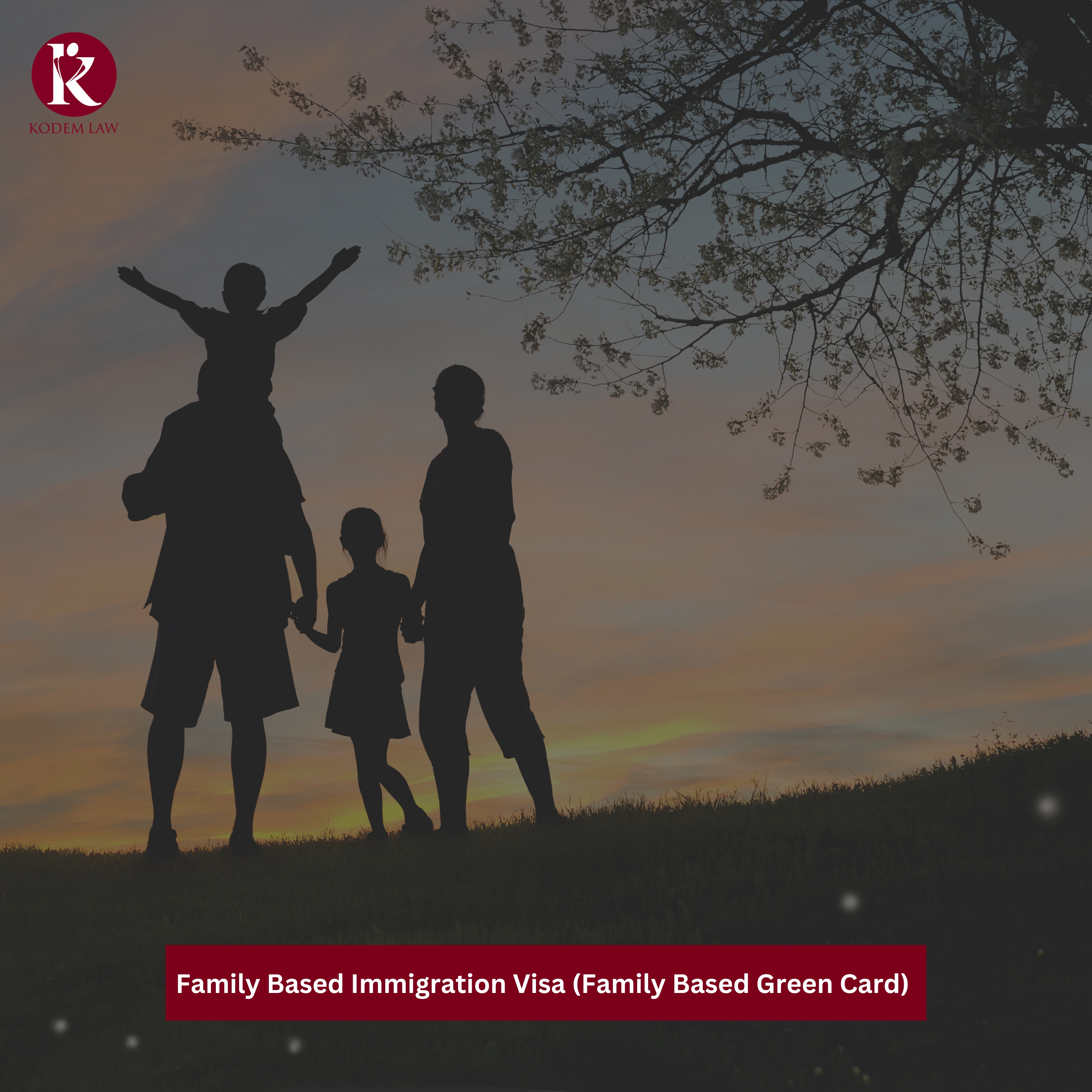
Are you eager to bring your family members to the US? Here’s how you can. Family-based immigration is a way for US citizens and permanent residents to sponsor their relatives for permanent residency in the US. From immediate relatives like spouses, parents, and unmarried children, to family preference visas for unmarried sons and daughters, married children, and siblings, there are a variety of visa options available.
In this post, we shall guide you through the eligibility requirements for family-based immigration and the different categories of family-based visas.
What is Family Based Immigration?
Family-based immigration is a system that allows foreign nationals to immigrate to a country based on their familial relationships with individuals who are already legal residents or citizens of that country. It prioritises family reunification by enabling eligible family members, such as spouses, parents, children, and siblings, to sponsor their relatives for immigration and obtain legal status in the country.
This visa allows foreign nationals to immigrate based on familial relationships with legal residents/citizens. Sponsoring family members file a petition, undergo reviews, and meet eligibility criteria. Categories and requirements vary by country. Seek professional guidance for specific information.
Who is Eligible for a Family Visa?
Eligibility for a family visa depends on the specific country’s immigration laws and regulations. However, in general, the following individuals may be eligible for a family visa:
Immediate Relatives: Spouses of US citizens, unmarried children under 21 years old of US citizens, and parents of US citizens (if the petitioner is at least 21 years old) are considered immediate relatives and have priority in the family-based immigration process.
Family Preference Categories: These categories include unmarried sons and daughters (over 21 years old) of US citizens, spouses, and unmarried children (under 21 years old) of permanent residents, married sons and daughters of US citizens, and brothers and sisters of US citizens.
Here’s a breakdown of these limited family preference categories:
- F1 (First Preference): This category is for unmarried adult sons and daughters (21 years or older) of US citizens.
- F2 (Second Preference): This category is for spouses and unmarried children of permanent residents. It is further split into two categories:
- F2A: Spouses and unmarried children (under 21 years old) of permanent residents.
- F2B: Unmarried adult sons and daughters (21 years or older) of permanent residents.
- F3 (Third Preference): This category is for married sons and daughters of US citizens.
- F4 (Fourth Preference): This category is for brothers and sisters of US citizens, provided the petitioner is at least 21 years old.
Note: Family visa availability varies based on numerical limits and priority dates. Waiting periods may apply due to high demand. Each family visa category has distinct requirements, such as specified relationships, age limits, and priority dates. It is recommended to consult the official US immigration authorities or an immigration attorney for the most up-to-date and accurate information regarding family visas in the United States.

Documents Required for a Visa Application
- Valid passport (with at least six months validity beyond the intended stay)
- Completed and signed visa application form
- Recent passport-sized photographs
- Proof of travel arrangements (flight reservations, itinerary, etc.)
- Proof of accommodation (hotel reservations, rental agreements, or invitation letter)
- Financial documentation (bank statements, sponsorship letters, income statements)
- Employment verification (letter from employer stating position, salary, and leave of absence)
- Travel insurance (covering medical, emergency, and cancellation)
- Purpose of visit documentation (invitation letter, acceptance letter, or itinerary)
- Additional supporting documents based on specific circumstances (marriage certificates, birth certificates, employment contracts, or educational qualifications)
Note: It’s always important to check with the embassy or consulate of the country you’re applying to for precise and up-to-date information.
Medical Examination for Family-Based Immigration Visa (Family-Based Green Card)
- A medical examination is typically required as part of the application process for a family-based immigration visa, also known as a family-based green card.
- The purpose of the medical examination is to evaluate the applicant’s health and determine if they have any medical conditions that may pose a public health or safety risk in the United States.
- The examination must be conducted by a designated civil surgeon approved by the U.S. Citizenship and Immigration Services (USCIS).
- The specific tests and procedures performed during the examination may vary but generally include a physical examination, review of medical history, blood tests, chest X-rays to screen for tuberculosis, and vaccinations.
- The cost of the medical examination is typically the responsibility of the visa applicant. The fee may vary depending on the location and specific tests conducted.
- After the examination, the civil surgeon will complete Form I-693, Report of Medical Examination, and Vaccination Record.
- The completed Form I-693 will be sealed in an envelope and should not be opened. It must be submitted to USCIS along with the immigration application.
US Family Visa Processing Time For India
- U.S. Family Visa processing times for India vary due to factors like visa type, individual circumstances, visa category, application volume, USCIS workload, and additional processing. On average, the process can span from a few months to over a year.
- The processing times for U.S. Family Visas in India differ. Immediate Relative visas (IR-1, IR-2, IR-3, IR-4) usually have shorter processing times, while Family Preference visas (F1, F2A, F2B, F3, F4) might experience longer processing due to demand and numerical limits.
- Delays in U.S. Family Visa processing can stem from documentation concerns or the requirement for additional reviews or interviews. To obtain accurate processing time details aligned with the visa category and personal situation, seeking guidance from an immigration attorney is recommended.
For comprehensive insights into U.S. Family Visa processing times, we encourage you to explore our visa bulletin available here. This resource provides valuable information to further inform and guide individuals in navigating the complexities of this process.
US Visa For Parents From India
- U.S. visas for parents from India are available through the family-based visa category
- The specific visa type for parents would fall under the Immediate Relative (IR) category
- The IR-5 visa is specifically designed for parents of U.S. citizens who are 21 years or older
- The processing time for IR-5 visas can vary but generally ranges from a few months to over a year
- To apply for a parent visa, the U.S. citizen child needs to submit a petition to the United States Citizenship and Immigration Services (USCIS), and the parent will need to go through the visa application process, including an interview at the U.S. embassy or consulate in India
Family-Based Visa Interview Questions
Here are five possible questions that could be asked:
1. What is the relationship between the petitioner and the beneficiary?
2. How did you meet your petitioner/US citizen?
3. Can you provide documentation or evidence of your relationship, such as photographs or communication records?
4. What are your plans once you arrive in the United States?
5. Have you ever visited the United States before? If so, what was the purpose of your visit and how long did you stay?
How Kodem Law Can Help You
Kodem Law assists with family-based immigration visas and green cards, helping reunite families and navigate the immigration process. Contact us today for future assistance: 888-955-6634 or info@kodemlaw.com
Frequently Asked Questions
1. How many relatives does an immigrant typically sponsor?
A- The number of relatives an immigrant can sponsor depends on their immigration status and the specific visa category. Generally, immigrants can sponsor immediate family members, such as spouses, unmarried children under 21, and parents, without numerical limitations. Other family members may be subject to numerical limits and availability under family preference visa categories. The exact number of relatives an immigrant can sponsor may vary in individual cases.
2. How many visas are available for sponsors’ extended family members?
A- The number of visas available for sponsors’ extended family members is subject to numerical limits set by the U.S. government under the family preference visa categories. These categories include unmarried adult children of U.S. citizens, married children of U.S. citizens, and siblings of U.S. citizens. The availability of visas for extended family members can vary each year based on the visa bulletin and the demand for those categories.
3. How many immigrants come through family visas?
A- The number of immigrants who come through family visas varies from year to year and depends on the immigration policies of each country. However, family-based immigration is a significant pathway for immigration in many countries, including the United States. In recent years, a substantial portion of immigrants, often in the tens of thousands or more, have entered through family-sponsored visas.
Navigating U.S. Family Visa Processing Times: Visa Bulletin Guide
For comprehensive insights into U.S. Family Visa processing times, we encourage you to explore our visa bulletin available here. This resource provides valuable information to further inform and guide individuals in navigating the complexities of this process.


[…] October Visa Bulletin for Family-Sponsored Preferences has been released by the U.S. Department of State. This bulletin provides important information for […]
[…] December Visa Bulletin Family-Sponsored Preferences has been released by the U.S. Department of State. USCIS will be accepting Filing Action Dates for […]
[…] January Visa Bulletin 2024 Family-Sponsored Preferences has been released by the U.S. Department of State. USCIS will be accepting Filing Action Dates for […]
My case has been at the nvc sinse 2021 waiting for interview . I have not heard from nvc till date. My priority date is 09/13/2018 . Please, can you help me move case forward?
[…] February Visa Bulletin 2024 Family-Sponsored Preferences has been released by the U.S. Department of State. USCIS will be accepting Filing Action Dates for […]